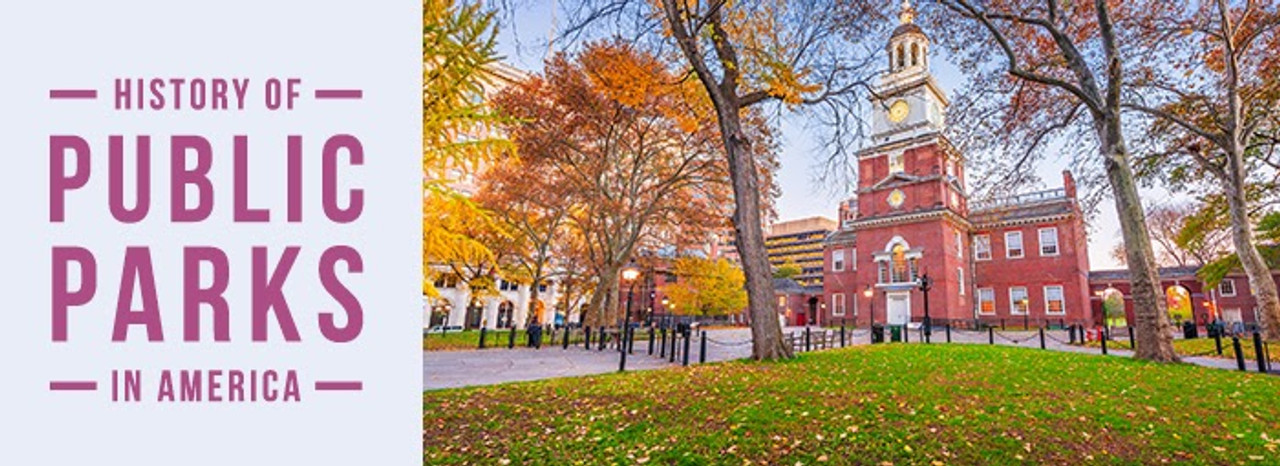The idea of a public park has a long and storied history. They’re places you can find grass, swing sets, and of course trash cans, but they are even more than that. Public parks are spaces for people to have recreation and interaction with each other and nature. This blog will give you insight and history about the inception and development of public parks and public recreational infrastructure.
The Origins: 1600-1700
The first official recorded public park was Boston Common, a public space created in 1634. The Common has had many purposes over the years. It was first owned by William Blaxton, who sold it to the Puritan founders of the Massachusetts Bay Colony. It was used as a cow pasture and has a long and storied history that resulted in it becoming an official public park in the 1830s. It was even a military camp used by the British before the Revolutionary War!
While the first manifestation of the public park was likely the town square, which has existed in civilizations and societies worldwide, Boston Common initially served as a shared pasture, later becoming an area where civic gatherings, parades, and other community activities were shared.
Like many towns, as they grow, the town square evolves into a park or a plaza in front of a county courthouse or town hall. Many of these squares eventually grew to hold monuments, fountains, and flagpoles to signify nationality. Some of them continue to serve as market or commercial gathering spaces to this day.
The Formative Years: The 1800s
Many of the most famous and greatest parks were built by the late 1800s. Some of them had notable designers that created many of the scenic areas in the country.
Frederick Law Olmsted created several notable parks during the late 1800s, including:
- Central Park in New York City, NY
- Washington and Jackson Parks in Chicago, IL
- Prospect Park in Brooklyn, NY
Olmsted was something of a pioneer in creating the public park. Central Park as we know it today was nothing but a bunch of uninhabitable swampland, but its creation would revolutionize the designs of the urban park in the US.
During this time there was a great surge in the creation of city parks, pleasure grounds, and cultural parks. Originally called “rural” or “country” parks, these areas were originally established on the edges of urban areas in the late 1800s and early 1900s as a response to concerns about urbanization and industrialization. People felt that there needed to be a space for citizens to engage with the outdoors.
Park designers would often replicate a rural setting to give opportunities for city dwellers to have a retreat from city life. Notable features in many of these parks included groves of trees, rolling meadows, lakes, and pathways. Some of the first zoos, formal gardens, music pavilions, and museums were also created during this period of time. The public park has long been part of a collective desire to escape the troubles of the modern world.
National Parks
National parks were established to conserve nature and wildlife so everyone may experience it for years to come. The first of which, Yellowstone National Park, was declared in 1872 by President Ulysses S. Grant. The creation of the National Park Service followed — less than close behind — in 1916.
Since then, the number and size of national parks in the US has grown to 419 parks, encompassing more than 84 million acres, spanning across each state, as well as multiple territories.
1900s
As urbanization continued, and cities continued to swell, neighborhood parks began to form. Growing cities began to surround and engulf the “rural” parks which had once lay on their outskirts. As the population increased, social and health concerns led cities to devote resources to the creation and maintenance of neighborhood parks, which were smaller but provided easier access for citizens to open and recreational spaces.
The “playground” is a result of reforms by the progressive movement in the 1900s to create “reform parks” which would offer children the ability to play and recreate more in individual neighborhoods. As the years continued on, more and more features were added to these parks, including:
- Ball fields
- Pools
- Indoor facilities
- Play equipment
Pocket parks began appearing in the 1960s. A pocket park is a public space that’s usually smaller than a quarter of an acre, but offers access to greenery, a place to sit outside, and a playground for children. They might be on vacant building lots or part of a larger building as well.
Present Day
Present-day parks have all of the amenities of historical parks, and there are even more innovations happening now. Modern parks still focus on creating a natural environment for children and adults to enjoy nature. If you’re interested in making public parks more inviting and functional, Trashcans Unlimited has the waste receptacles — and more — for you to keep parks clean and inviting.
Stay true to the history of parks and bring nature into the space with garden planters and flowers; get wood trash cans that lend that natural, rustic feel, or metal ones to match the fencing. Provide benches and tables for patrons to sit and enjoy nature. And don’t forget about our furry friends either! Dogs and their people need waste receptacles, bag dispensers, and fixtures too. Parks will always need trash cans and Trash Cans Unlimited will be here to provide them.

